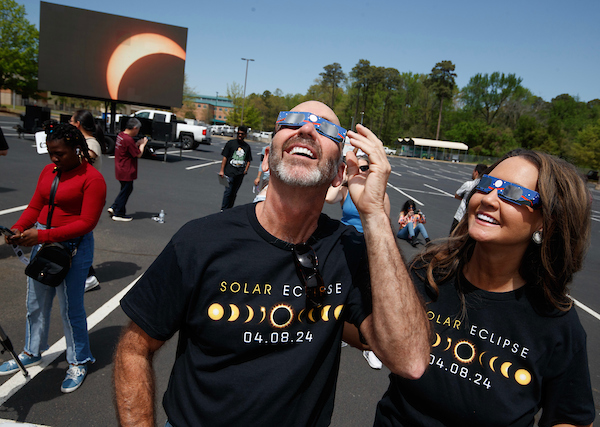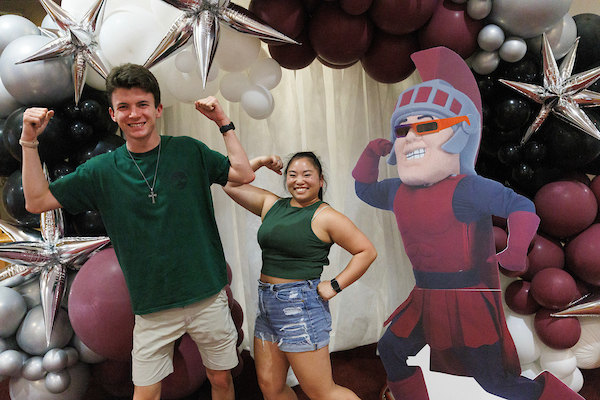Thousands Enjoy Total Solar Eclipse Celebration at UA Little Rock

The University of Arkansas at Little Rock hosted more than 4,000 people during a triumphant total solar eclipse event that captivated students, faculty, staff, and community members alike.
“The celebration we hosted on campus was spectacular and drew visitors locally and from around the country,” Chancellor Christina Drale said. “The educational programs and displays showcased the academic talent we have on campus, and all of the volunteers helped make this an all-around fun event for everyone.”
More than 200 volunteers helped the event become a huge success! The event was planned for many months by the UA Little Rock Eclipse Committee, comprised of Ann Bain, Carrie Phillips, Gregory Guisbiers, Alicia Dorn, Aaron Birmingham, Angie Faller, Brian Berry, Justin Early, Kara Brown, Katina White, Larry Whitman, Leslie Hutchins, Meaghan Milliorn, Muriel Schrepfer, Ross Bradley, Regina Wade-Carter, Sarah Beth Estes, Sadie Lea, Tom Clifton, Toni Boyer, Tansel Karabacak, and Cody Decker.
The solar eclipse event helped spread word about UA Little Rock and its experts far and wide. Stories in the media generated 3.5 billion media impressions and 320 media alerts!
“It is my second time watching a total solar eclipse, but the magic still operates like the very first time! It is an incredible feeling of satisfaction to be able to watch this celestial show!” said Dr. Gregory Guisbiers, associate professor of physics at UA Little Rock.
Amidst a backdrop of celestial splendor, participants gathered at the Jack Stephens Center to witness this rare astronomical phenomenon, forging unforgettable memories and fostering a sense of unity and awe.
“It’s an amazing event,” said Dr. David Montague, associate vice chancellor for student affairs – student success. “It’s so nice to see people here enjoying this experience and learning so many things. The energy today is very special indeed.”
As the sun vanished behind the moon for nearly two-and-a-half minutes, the campus buzzed with excitement and scientific curiosity, marking a momentous occasion that will be cherished for years to come.
“A lot of people missed seeing a total solar eclipse that took place in the western United States seven years ago, but lots of people had access to this total solar eclipse and didn’t have to travel as far to see it,” said Dr. Miles Blanton, advanced instructor of physics and astronomy. “It’s a novel event, and it’s so predictable. That’s what surprises a lot of people. You can predict it down to the minute. It feels like you are in control when we are not in control of so much of the natural world.”
As the solar eclipse drew near, the crowd grew silent as the music stopped, the temperature fell, and a breeze could be felt in the air. As total darkness fell at 1:51 p.m., members of the crowd cheered, gasped, and cried as they witnessed the celestial event.
“It was so awesome to be here in this breathtaking moment,” Kristi Smith, associate vice chancellor of alumni and development, said after watching the eclipse. “We had the perfect weather, and all the stars aligned for this amazing event. It is so wonderful that our university brought together so many people to have such a great event for the community.”

The community event brought together a wonderful mix of the arts and the sciences. UA Little Rock provided observation sessions with telescopes, an inflatable planetarium, a Foucault’s pendulum, Cavendish’s balance, gravity well, and meteorites on display. The Arkansas Space Grant Consortium provided 30,000 pairs of complementary solar eclipse glasses.
“I’m a kid on the inside, and I came here to experience the solar eclipse,” said Joshua Pack, a junior double majoring in chemistry and biology. “I was surprised by the amount of stuff to do at the event. I don’t travel a lot, so this was a unique opportunity to see the solar eclipse in my hometown.”
Employees and students from the College of Humanities, Arts, Social Sciences, and Education had more than 30 people volunteer as face painters. Students designed a custom face painting template and solar eclipse sticker.
In one of many scientific demonstrations on display, UA Little Rock’s Emerging Analytics Center created a special virtual reality experience, Total Solar Eclipse VR 2024. The project was put together by students Carlos Ochoa, Cecily Mobley, Ashlly Lambaren, Colin McNerny, and Eric Helms with guidance from Jason Zak, lead artist, and Wesley Ferguson, research associate.
“The VR app we made takes you into space, where you can see the perspective of the total solar eclipse from a completely new angle,” said Colin NcNerny, a senior electronic and computer engineering major. “You can’t look directly at the Sun in real life without it hurting your eyes. In virtual space, you can look at the sun in great detail. We also created a Snapchat filter which shows the user wearing solar eclipse glasses, and you can see the eclipse reflected in the lenses.”
Visitors traveled from near and far to take part in the day’s events.
“My son wants to be an astrophysicist, so Little Rock was a close drive to spark the imagination of our future generation,” said Danielle Hart, who drove from Huntsville, Alabama, to watch the eclipse with her family at UA Little Rock. “It was so absolutely incredible. That moment when the sky goes dark and the crowd cheers, it’s a very magical moment.”
The solar eclipse celebration was sponsored by the Donaghey Foundation, Arkansas Space Grant Consortium, and the UA Little Rock Donaghey College of Science, Technology, Engineering, and Math.
